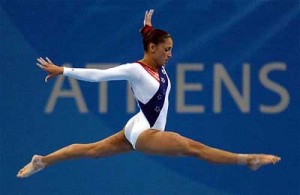
South Asian women in the U.S. face many obstacles, including the cultural patriarchy, the glass ceiling, pay gap, maternity leave, and expectations to cook, clean and care for the family. Trying to follow one’s passion is hard enough — trying to break into a male dominated industry like sports may seem nearly impossible for South Asian women. But it’s not; over the last decade in the sports community South Asian women have been making an impact.
Mohini Bhardwaj, the first South Asian American gymnast, earned a team silver medal at the 2004 Summer Olympics in Athens, Greece. There are also Indian tennis stars like Sania Mirza, Shikha Uberoi and Neha Uberoi. In media, Aditi Kinkhabwala, who was a journalist for the Wall Street Journal, is now a reporter for the NFL Network. Bloomberg View columnist Kavitha A. Davidson writes about sports. Then there’s Megha Parekh, vice president and general counsel of the NFL’s Jacksonville Jaguars.
Taking this Steelers loss well, aren't you? … RT @JohnMeketa @AKinkhabwala Did the dot on your forehead freeze and fall off?
— Aditi Kinkhabwala (@AKinkhabwala) December 9, 2013
Being a woman in a testosterone-filled industry is tough enough, and being a South Asian woman is even tougher. There are a countless number of incidents where South Asian women are criticized for being in the industry. For instance, Kinkhabwala was covering the Pittsburgh Steelers game against the Miami Dolphins on December 8, 2013, when she received a racist remark on Twitter. Also, Priyanka Chopra has talked about receiving racist remarks for being NFL Thursday Night Football’s opening act.
 There’s also overcoming hardships that start at home. You may remember the movie Bend It Like Beckham in which Jess, a young South Asian female in the UK, aspired to become a soccer player. But her parents wanted her to go to school and get married instead of going to college on a soccer scholarship. Our reality isn’t like a movie but the expectations to succeed in school, be a good wife, and good mother can overshadow the path to follow one’s dream. How can girls and young women in school get through these obstacles? Parents and families need to understand the value and impact young women can have in this industry.
There’s also overcoming hardships that start at home. You may remember the movie Bend It Like Beckham in which Jess, a young South Asian female in the UK, aspired to become a soccer player. But her parents wanted her to go to school and get married instead of going to college on a soccer scholarship. Our reality isn’t like a movie but the expectations to succeed in school, be a good wife, and good mother can overshadow the path to follow one’s dream. How can girls and young women in school get through these obstacles? Parents and families need to understand the value and impact young women can have in this industry.
There are obstacles that all women have to overcome in sports no matter what race or nationality. But what’s being done to make sure South Asian women overcome these hardships?
More and more South Asian women want to be in the sporting industry. There are young girls who want to be athletes, journalists or agents and who look up to individuals like Mirza and Kinkhabwala. The “pay it forward” model needs to happen. These girls and young women looking to get into the industry and women who are already in the industry need a support network, a community. Being able to relate to someone can help in achieving success, and building relationships can drive that process. To start building a community, a South Asian women in sports Twitter chat will begin on Wednesday, February 12, from 8 to 9 p.m. EST. Join the conversation and follow along with the #SAWSports hashtag.
You can follow Neha on Twitter at @NehaSoneji.













1 thought on “South Asian Women in Sports: Overcoming Obstacles and Building Support”
Comments are closed.